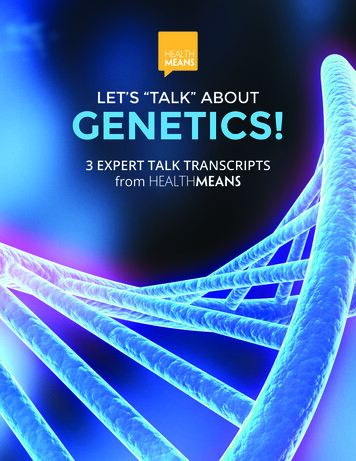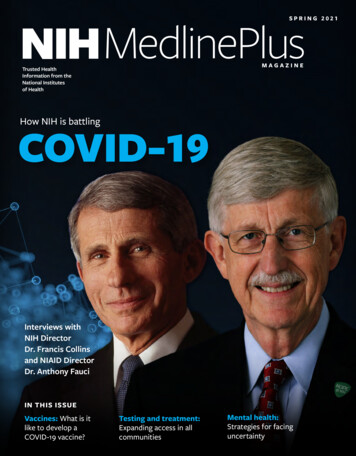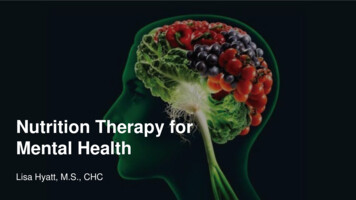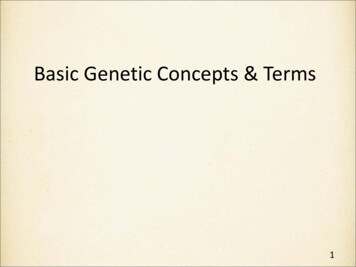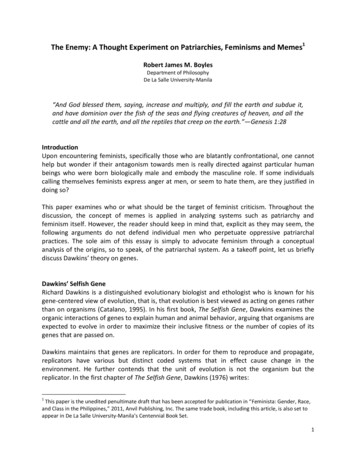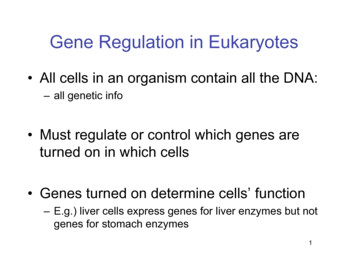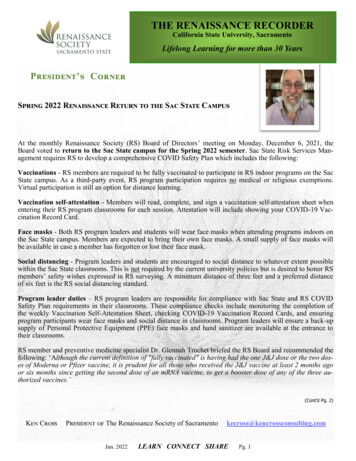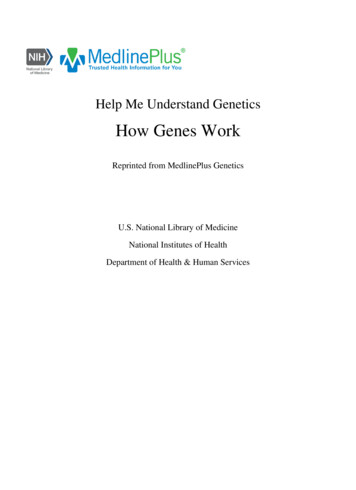
Transcription
Help Me Understand GeneticsHow Genes WorkReprinted from MedlinePlus GeneticsU.S. National Library of MedicineNational Institutes of HealthDepartment of Health & Human Services
Table of Contents1What are proteins and what do they do?12How do genes direct the production of proteins?53Can genes be turned on and off in cells?74What is epigenetics?85How do cells divide?106How do genes control the growth and division of cells?127How do geneticists indicate the location of a gene?16Reprinted from MedlinePlus Genetics (https://medlineplus.gov/genetics/)i
How Genes Work1What are proteins and what do they do?Proteins are large, complex molecules that play many critical roles in the body. They domost of the work in cells and are required for the structure, function, and regulation ofthe body’s tissues and organs.Proteins are made up of hundreds or thousands of smaller units called amino acids,which are attached to one another in long chains. There are 20 different types of aminoacids that can be combined to make a protein. The sequence of amino acidsdetermines each protein’s unique 3-dimensional structure and its specific function.Amino acids are coded by combinations of three DNA building blocks (nucleotides),determined by the sequence of genes.Proteins can be described according to their large range of functions in the body, listedin alphabetical order:Antibody. Antibodies bind to specific foreign particles, such as viruses and bacteria, tohelp protect the body.Example: Immunoglobulin G (IgG) (Figure 1)Enzyme. Enzymes carry out almost all of the thousands of chemical reactions that takeplace in cells. They also assist with the formation of new molecules by reading thegenetic information stored in DNA.Example: Phenylalanine hydroxylase (Figure 2)Messenger. Messenger proteins, such as some types of hormones, transmit signals tocoordinate biological processes between different cells, tissues, and organs.Example: Growth hormone (Figure 3)Structural component. These proteins provide structure and support for cells. On alarger scale, they also allow the body to move.Example: Actin (Figure 4)Transport/storage. These proteins bind and carry atoms and small molecules withincells and throughout the body.Example: Ferritin (Figure 5)Reprinted from MedlinePlus Genetics (https://medlineplus.gov/genetics/)1
FIGURE 1: The structure of immunoglobulin G, including foreign particlebinding sites.FIGURE 2: The phenylalanine hydroxylase protein consists of four subunits.Reprinted from MedlinePlus Genetics (https://medlineplus.gov/genetics/)2
FIGURE 3: The structure of growth hormone, and growth hormone boundto its receptor.FIGURE 4: An actin filament consisting of multiple subunits.Reprinted from MedlinePlus Genetics (https://medlineplus.gov/genetics/)3
FIGURE 5: Ferritin protein consisting of 24 subunits.For more information about proteins and their functions:Arizona State University's "Ask a Biologist" discusses the different kinds of proteins eins) and what they do.The textbook Molecular Biology of the Cell (4th edition, 2002), from the NCBI Bookshelf,offers a detailed introduction to protein function rinted from MedlinePlus Genetics (https://medlineplus.gov/genetics/)4
2How do genes direct the production of proteins?Most genes contain the information needed to make functional molecules calledproteins. (A few genes produce regulatory molecules that help the cell assembleproteins.) The journey from gene to protein is complex and tightly controlled within eachcell. It consists of two major steps: transcription and translation. Together, transcriptionand translation are known as gene expression.During the process of transcription, the information stored in a gene's DNA is passed toa similar molecule called RNA (ribonucleic acid) in the cell nucleus. Both RNA and DNAare made up of a chain of building blocks called nucleotides, but they have slightlydifferent chemical properties. The type of RNA that contains the information for makinga protein is called messenger RNA (mRNA) because it carries the information, ormessage, from the DNA out of the nucleus into the cytoplasm.Translation, the second step in getting from a gene to a protein, takes place in thecytoplasm. The mRNA interacts with a specialized complex called a ribosome, which "reads" the sequence of mRNA nucleotides. Each sequence of three nucleotides, calleda codon, usually codes for one particular amino acid. (Amino acids are the buildingblocks of proteins.) A type of RNA called transfer RNA (tRNA) assembles the protein,one amino acid at a time. Protein assembly continues until the ribosome encounters a “stop” codon (a sequence of three nucleotides that does not code for an amino acid).The flow of information from DNA to RNA to proteins is one of the fundamentalprinciples of molecular biology. It is so important that it is sometimes called the “centraldogma.”Through the processes of transcription and translation, information from genes is usedto make proteins. (Figure 6)Reprinted from MedlinePlus Genetics (https://medlineplus.gov/genetics/)5
FIGURE 6: DNA is transcribed into mRNA, which is transported into the cellcytoplasm and translated into a protein.For more information about making proteins:The Genetic Science Learning Center at the University of Utah offers an interactiveintroduction to transcription and translation a).North Dakota State University's Virtual Cell Animation Collection offers videos thatillustrate the processes of transcription ion/movie-flash.htm) and translation n/movie-flash.htm).The New Genetics new-genetics/Pages/Home.aspx), a publication of the National Institute of General Medical Sciences,includes discussions of transcription and translation.Biointeractive from the Howard Hughes Medical Institute illustrates the stages in theflow of information from DNA to RNA to protein. s/central-dogma-and-genetic-medicine) This tool also gives examples ofhow modern technologies that target the different stages are used to treat geneticdiseases.Reprinted from MedlinePlus Genetics (https://medlineplus.gov/genetics/)6
3Can genes be turned on and off in cells?Each cell expresses, or turns on, only a fraction of its genes at any given time. The restof the genes are repressed, or turned off. The process of turning genes on and off isknown as gene regulation. Gene regulation is an important part of normal development.Genes are turned on and off in different patterns during development to make a braincell look and act different from a liver cell or a muscle cell, for example. Gene regulationalso allows cells to react quickly to changes in their environments. Although we knowthat the regulation of genes is critical for life, this complex process is not yet fullyunderstood.Gene regulation can occur at any point during gene expression, but most commonlyoccurs at the level of transcription (when the information in a gene’s DNA is passed tomRNA). Signals from the environment or from other cells activate proteins calledtranscription factors. These proteins bind to regulatory regions of a gene and increaseor decrease the level of transcription. By controlling the level of transcription, thisprocess can determine when and how much protein product is made by a gene.For more information about gene regulation:The National Human Genome Research Institute provides a definition of generegulation ulation) in their TalkingGlossary of Genetic Terms.The Genetic Science Learning Center at the University of Utah offers an explanation ofgene expression as it relates to disease risk xpression/).Additional information about gene expression ression) is available from yourgenome.org, a service of the Wellcome Trust.The Khan Academy has an educational unit on gene regulation regulation), including videos about gene regulation inbacteria and eukaryotes.Reprinted from MedlinePlus Genetics (https://medlineplus.gov/genetics/)7
4What is epigenetics?Epigenetics is the study of how cells control gene activity without changing the DNAsequence."Epi-"means on or above in Greek,and "epigenetic" describes factors beyondthe genetic code. Epigenetic changes are modifications to DNA that regulate whethergenes are turned on or off. These modifications are attached to DNA and do not changethe sequence of DNA building blocks. Within the complete set of DNA in a cell (genome), all of the modifications that regulate the activity (expression) of the genes is known asthe epigenome.Because epigenetic changes help determine whether genes are turned on or off, theyinfluence the production of proteins in cells. This regulation helps ensure that each cellproduces only proteins that are necessary for its function. For example, proteins thatpromote bone growth are not produced in muscle cells. Patterns of epigeneticmodification vary among individuals, in different tissues within an individual, and even indifferent cells within a tissue. Environmental influences, such as a person’s diet andexposure to pollutants, can impact the epigenome. Epigenetic modifications can bemaintained from cell to cell as cells divide and, in some cases, can be inherited throughthe generations.A common type of epigenetic modification is called DNA methylation. DNA methylationinvolves the attachment of small chemical groups called methyl groups (each consistingof one carbon atom and three hydrogen atoms) to DNA building blocks. When methylgroups are present on a gene, that gene is turned off or silenced, and no protein isproduced from that gene.Another common epigenetic change is histone modification. Histones are structuralproteins in the cell nucleus. DNA wraps around histones, giving chromosomes theirshape. Histones can be modified by the addition or removal of chemical groups, such asmethyl groups or acetyl groups (each consisting of two carbon, three hydrogen, and oneoxygen atoms). The chemical groups influence how tightly the DNA is wrapped aroundhistones, which affects whether a gene can be turned on or off.Errors in the epigenetic process, such as modification of the wrong gene or failure toadd a chemical group to a particular gene or histone, can lead to abnormal gene activityor inactivity. Altered gene activity, including that caused by epigenetic errors, is acommon cause of genetic disorders. Conditions such as cancers, metabolic disorders,and degenerative disorders have been found to be related to epigenetic errors.Scientists continue to explore the relationship between the genome and the chemicalcompounds that modify it. In particular, they are studying the effects that epigeneticmodifications and errors have on gene function, protein production, and human health.For more information about the epigenome:The National Institutes of Health (NIH) offers the NIH Roadmap Epigenomics Project (http://www.roadmapepigenomics.org/), which provides epigenome maps of a variety ofcells to begin to assess the relationship between epigenomics and human disease.Reprinted from MedlinePlus Genetics (https://medlineplus.gov/genetics/)8
Human Epigenome Toolset (http://www.genboree.org/site/epigenomics toolset) fromBaylor College of Medicine allows for comparison of the epigenomes of many speciesand cell types.Ongoing research is being done with the International Human Epigenome Consortium (http://ihec-epigenomes.org/).The University of Utah provides an interactive epigenetics tutorial cs/).The National Human Genome Research Institute provides a fact sheet /Epigenomics-Fact-Sheet) on Epigenomics.Many tools for understanding epigenomics are available through the NIH Common FundEpigenomics Project d from MedlinePlus Genetics (https://medlineplus.gov/genetics/)9
5How do cells divide?There are two types of cell division: mitosis and meiosis. Most of the time when peoplerefer to “cell division,” they mean mitosis, the process of making new body cells. Meiosisis the type of cell division that creates egg and sperm cells.Mitosis is a fundamental process for life. During mitosis, a cell duplicates all of itscontents, including its chromosomes, and splits to form two identical daughter cells.Because this process is so critical, the steps of mitosis are carefully controlled bycertain genes. When mitosis is not regulated correctly, health problems such as cancercan result.The other type of cell division, meiosis, ensures that humans have the same number ofchromosomes in each generation. It is a two-step process that reduces thechromosome number by half—from 46 to 23—to form sperm and egg cells. When thesperm and egg cells unite at conception, each contributes 23 chromosomes so theresulting embryo will have the usual 46. Meiosis also allows genetic variation through aprocess of gene shuffling while the cells are dividing.Mitosis and meiosis, the two types of cell division. (Figure 7)FIGURE7: The cell division processes of mitosis and meiosis.For more information about cell division:The National Human Genome Research Institute's Talking Glossary providesReprinted from MedlinePlus Genetics (https://medlineplus.gov/genetics/)10
information about mitosis (https://www.genome.gov/genetics-glossary/Mitosis) and meiosis .Yourgenome from the Wellcome Trust outlines the similarities and differences betweenmitosis and meiosis eiosis).Reprinted from MedlinePlus Genetics (https://medlineplus.gov/genetics/)11
6How do genes control the growth and division of cells?A variety of genes are involved in the control of cell growth and division. The cellreplicates itself in an organized, step-by-step fashion known as the cell cycle. Tightregulation of this process ensures that a dividing cell’s DNA is copied properly, anyerrors in the DNA are repaired, and each daughter cell receives a full set ofchromosomes. The cell cycle has checkpoints (also called restriction points), whichallow certain genes to check for problems and halt the cycle for repairs if somethinggoes wrong.If a cell has an error in its DNA that cannot be repaired, it may undergo self-destruction(apoptosis (Figure 8)). Apoptosis is a common process throughout life that helps thebody get rid of cells that no longer work or that it doesn’t need. Cells that undergoapoptosis break apart (Figure 9) and are recycled by a type of white blood cell called amacrophage. Apoptosis protects the body by removing genetically damaged cells thatcould lead to cancer, and it plays an important role in the development of the embryoand the maintenance of adult tissues.Reprinted from MedlinePlus Genetics (https://medlineplus.gov/genetics/)12
FIGURE 8: If a cell is unable to repair errors, it programs itself to die viaapoptosis.Reprinted from MedlinePlus Genetics (https://medlineplus.gov/genetics/)13
FIGURE 9: A white blood cell and an apoptotic cell.Disruption of normal regulation of the cell cycle can lead to diseases such as cancer.When the cell cycle proceeds without control, cells can divide without order andaccumulate genetic errors that can lead to a cancerous tumor (Figure 10).FIGURE 10: A tumor in the liver; inset shows the progression from anormal cell to one in which genetic changes accumulate, leading to rapidReprinted from MedlinePlus Genetics (https://medlineplus.gov/genetics/)14
and disorganized cell division.For more information about cell growth and division:The National Human Genome Research Institute's Talking Glossary providesinformation about the cell cycle le).The National Cancer Institute's fact sheet What is Cancer? /what-is-cancer) explains the growth of cancerous tumors.Reprinted from MedlinePlus Genetics (https://medlineplus.gov/genetics/)15
7How do geneticists indicate the location of a gene?Geneticists use maps to describe the location of a particular gene on a chromosome.One type of map uses the cytogenetic location to describe a gene’s position. Thecytogenetic location is based on a distinctive pattern of bands created whenchromosomes are stained with certain chemicals. Another type of map uses themolecular location, which is a precise description of a gene's position on a chromosome.The molecular location is based on the sequence of DNA building blocks (nucleotides)that make up the chromosome.Cytogenetic locationGeneticists use a standardized way of describing a gene's cytogenetic location. In mostcases, the location describes the position of a particular band on a stained chromosome:17q12It can also be written as a range of bands, if less is known about the exact location:17q12-q21The combination of numbers and letters provide a gene's “address” on a chromosome.This address is made up of several parts: The chromosome on which the gene can be found. The first number or letter usedto describe a gene's location represents the chromosome. Chromosomes 1 through22 (the autosomes) are designated by their chromosome number. The sexchromosomes are designated by X or Y. The arm of the chromosome. Each chromosome is divided into two sections (arms)based on the location of a narrowing (constriction) called the centromere. Byconvention, the shorter arm is called p, and the longer arm is called q. Thechromosome arm is the second part of the gene's address. For example, 5q is thelong arm of chromosome 5, and Xp is the short arm of the X chromosome. The position of the gene on the p or q arm. The position of a gene is based on adistinctive pattern of light and dark bands that appear when the chromosome isstained in a certain way. The position is usually designated by two digits(representing a region and a band), which are sometimes followed by a decimalpoint and one or more additional digits (representing sub-bands within a light or darkarea). The number indicating the gene position increases with distance from thecentromere. For example: 14q21 represents position 21 on the long arm ofchromosome 14. 14q21 is closer to the centromere than 14q22.Sometimes, the abbreviations “cen” or “ter” are also used to describe a gene'scytogenetic location. “Cen” indicates that the gene is very close to the centromere. Forexample, 16pcen refers to the short arm of chromosome 16 near the centromere. “Ter”stands for terminus, which indicates that the gene is very close to the end of the p or qReprinted from MedlinePlus Genetics (https://medlineplus.gov/genetics/)16
arm. For example, 14qter refers to the tip of the long arm, or the very end, of chromosome14.The CFTR gene is located on the long arm of chromosome 7 at position 7q31.2. (Figure11)FIGURE 11: The CFTR gene is located on the long (q) arm ofchromosome 7 at position 31.2.Molecular locationThe Human Genome Project, an international research effort completed in 2003,determined the sequence of nucleotides for each human chromosome. This sequenceinformation allows researchers to provide a more specific address than the cytogeneticlocation for many genes. A gene’s molecular address pinpoints the location of that genein terms of nucleotides. It describes the gene’s precise position on a chromosome andindicates the size of the gene. Knowing the molecular location also allows researchersto determine exactly how far a gene is from other genes on the same chromosome.Different groups of researchers often present slightly different values for a gene’smolecular location. Researchers interpret the sequence of the human genome using avariety of methods, which can result in small differences in a gene’s molecular address.Reprinted from MedlinePlus Genetics (https://medlineplus.gov/genetics/)17
For more information on genetic mapping:The National Human Genome Research Institute explains how researchers create agenetic map /Genetic-Mapping-Fact-Sheet).Information about assembling and annotating the genome (https://www.ncbi.nlm.nih.gov/guide/genomes-maps/) is available from NCBI.Reprinted from MedlinePlus Genetics (https://medlineplus.gov/genetics/)18
maintained from cell to cell as cells divide and, in some cases, can be inherited through the generations. A common type of epigenetic modification is called DNA methylation. DNA methylation involves the attachment of small chemical groups called methyl groups (each consisting of one carb

